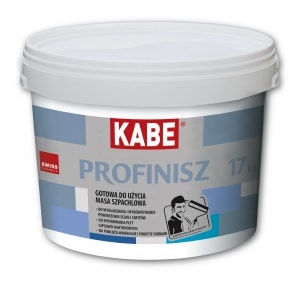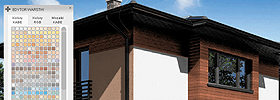PROFINISZ

Ready-to-use finishing compound
Ready-to-use finishing compound for manual smoothening of wall and ceiling surfaces and joining drywalls inside buildings. It is especially recommended for final and finishing levelling and smoothening of surfaces before painting. Thanks to its white colour and smooth surface it allows to reduce a quantity of paint coatings needed to achieve a full decorative effect. The product has a form of easy to apply plastic compound which after hardening may be easily processed mechanically by sanding. PROFINISZ ready-to-use finishing compound may also be used for joining drywalls by using a reinforcing tape.
To be applied on all typical mineral substrates such as concrete, cement plasters, cement-lime plasters, lime plasters and skim coats and drywalls.
Note: The product should not be used in rooms where constant relative humidity exceeds 70%.
| Base binder: | organic binder; |
| Colour: | white; |
| Maximum thickness of one layer: | up to 3 mm; |
| Average coverage: | ca. 1.8 kg/m² per each 1 mm of the layer thickness; |
| Temperature of application (air and substrate): | from +5°C to +25°C; |
| Relative humidity: | ≤ 70%; |
| Adhesion/cohesion (drywall): | > 0.25 [N/mm2]; |
| Concrete substrate adhesion: | ≥ 0.3 MPa; |
| Resistance to cracking: | no cracks within the zone up to 50 mm from the thin wedge end; |
| Packaging: | Single-use plastic packaging containing 4 kg, 7 kg and 17 kg of the product; |
| Storage: | The product should be stored in its sealed packaging in cool condition but protected from frost. Note: The product must be kept out of the reach of children; |
| Shelf life: | 12-month shelf life from date of production (production date and batch number are printed on the side of the packaging). |
• Quick and easy application
• Smooth, decorative surface
• High level of whiteness
• Ready for direct use
• Easy to apply and process mechanically
• Possibility of joining drywalls
SUBSTRATE PREPARATION: Apply to a sound/stable and clean substrate (without cracks and delaminations), degreased, dry, and biological or chemical efflorescence free. In the case of fungal growth, the substrate should be mechanically cleaned and then disinfect with an indoor fungicide. Any loose layers not bound to the substrate (i.e. dirt, dust, loose render or flaked coatings) should be removed. Old and/or dirty substrates should be washed off and degreased with water and CLEANFORCE cleaning agent. Present holes, unevennesses and cracks should be filled in pursuant to the best construction practices. Substrates covered with well-set dispersion coating to be ground with sandpaper and dedusted before ready-to-use finishing compound application. If the product is applied on newly completed mineral substrates (i.e. cement-lime plasters, cement plasters and concrete substrates) — min. 2-week curing period is required.
PRIMING: Absorbent substrates should be primed with BUDOGRUNT WG diluted with water (1:1 ratio) before ready-to-use finishing compound application.
READY-TO-USE FINISHING COMPOUND PREPARATION: The product should be thoroughly mixed directly before use.
APPLICATION: Apply a thin, uniform layer of ready-to-use finishing compound on the substrate with the thickness from 1 mm to 3 mm, using a stainless steel trowel. If greater unevenness is present, finishing compound to be applied in a few layers after the previous layer hardens. If drywalls are joined, it is necessary to set reinforcing tape made of geotextile fabric (interlining) or glass fiber mesh in the places of connection in finishing compound. After the
surface dries, it may be ground with a trowel with a mesh or sandpaper.
DRYING: The layer of finishing compound with the thickness of 3 mm applied on the substrate may be further processed after ca. 12 hours (20°C, 55% RH).
Note: Substrate water absorbency and air circulation in the room significantly influence on the drying time of finishing compound.
USEFUL HINTS: The application and drying of the product requires a temperature (air and substrate) between 5-25°C. All tools to be cleaned with water after finishing work.


 PROFINISZ - TDS
PROFINISZ - TDS